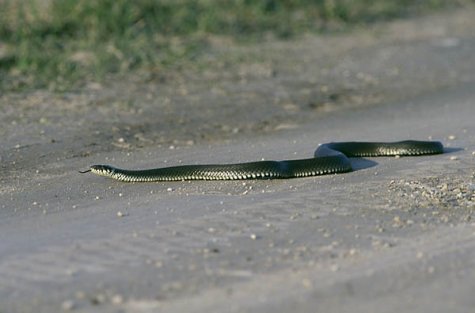Grass snakes hatching
Photo: Arne Ader
Translation: Liis
Grass snake on a road.
| Grass snake | Nastik |
The grass snake isn’t venomous, and people have tolerated it near their dwellings since faraway times because small rodents are on the menu of snakes and their presence keeps the rodents away.
The colour of the back of this snake is very variable – olive green, brownish grey; on the dark back there may be pale flecks and the underbelly is pale-coloured. On Saaremaa and Ruhnu completely black individuals can be encountered.
Clear identification signs are the yellow- to orange-coloured spots or “collar” at the back of the neck, but these too vary sometimes, from white to grey. The wholly black individuals may lack the spots. The length of fully grown male grass snakes is around seventy centimetres, which is about half less than the length of the female snakes: a very noticeable difference in size.
Towards the end of August and in September “baby grass snake“ are hatched from the 2-4 centimetres long eggs, sticking together and with a leathery shell. One female grass snake can lay up to forty eggs and sometimes the same egg-laying place is used by several snakes. Newly hatched snakes are about 15 centimetres long, and at once crawl apart and start an independent life. Natural hatching places may be dung and leaf heaps, rotting tree stumps, rotting forest matter, seaweed heaps on the shore ... The young grass snakes have many enemies.









